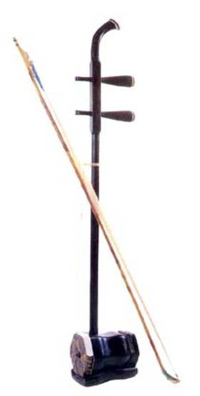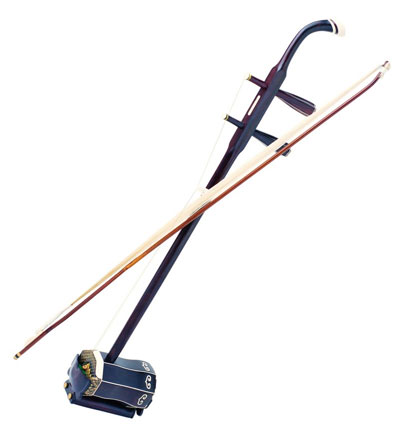 Erhu
Erhu
 The erhu is a very famous stringed instrument in China. Its history can be traced back to theTang Dynasty(618-907). It was welcomed among the ethnic people of the northeastern part of China. The erhu has long been the instrumental accompaniment in traditional dramas.
The erhu is a very famous stringed instrument in China. Its history can be traced back to theTang Dynasty(618-907). It was welcomed among the ethnic people of the northeastern part of China. The erhu has long been the instrumental accompaniment in traditional dramas.
The erhu's structure is quite simple. There is a slim neck about 80 centimeters, on the surface of which two strings are fixed. In addition, there is a cup-shaped canister and a bow made of horsehair. While performing, the musician is usually seated, with the organ and bow held in the left and right hand respectively.
The range consists of three octaves. The somewhat melancholic tone is close to the human voice and is good at conveying sad emotions. Some people call it the Chinese violin.
The making, renovation, and performing skills of the erhu have been greatly improved since 1949. It can be played solo or as an accompaniment in operas and traditional dramas. In ethnic orchestras, the erhu even plays the leading role, just as the violin does in Western orchestras.
The erhu is highly popular with the Chinese people because of its simple design and low cost. Nearly every Chinese family loves it.
 Gaohu
Gaohu
 The gaohu is generally called the alt erhu, as it developed from the erhu. Its development is closely linked to Cantonese music.
The gaohu is generally called the alt erhu, as it developed from the erhu. Its development is closely linked to Cantonese music.
Cantonese music is usually performed with folk instruments. In the beginning, there was no gaohu in Cantonese music. Around the 1920s, the Cantonese musician and performer Lu Wencheng made great improvements to the erhu. He changed the silk strings to steel ones, and raised the tones. When performing, he put the canister between his legs. The gaohu soon became the leading instrument in Cantonese music.
The material, making, and structure of the gaohu are similar to that of the erhu. The biggest difference is the canister. Designers had few limits in making the instrument. Some designers changed the round canister into a flat round one, which raised the volume. Some changed it to a three-stringed instrument instead of a two-stringed one, which expanded the range.
The gaohu has a clear and bright sound. Along with this characteristic, the full-bodied bass part has been given great prominence in the band. As a rule, the gaohu is given a highly valued seat in Chinese ethnic orchestras. In addition, it is especially good at performing lively rhythms. For that reason, it is often used to perform the accompaniment of theme songs.
